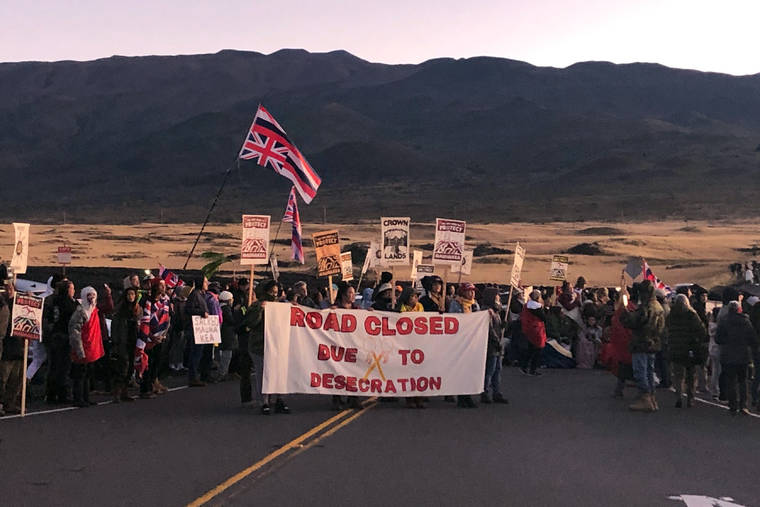HONOLULU — Police arrested elderly protesters, some using wheelchairs and canes, as they blocked a road Wednesday to Hawaii’s highest peak to try to stop construction of a giant telescope on land some Native Hawaiians consider sacred.
Protest leader Kealoha Pisciotta told The Associated Press that hundreds of demonstrators moved aside to allow police to take away about 30 elders, called kupuna in Hawaiian, who were prepared to be arrested.
“They’re taking our kupuna,” Pisciotta said, sobbing.
Some used canes and strollers to walk, while others were taken in wheelchairs to police vans. Those who could walk on their own were led away with their hands in zip ties.
State spokesman Dan Meisenzahl confirmed the arrests. He said in an email that the number of people arrested and what charges may they face were not yet available.
Officials said construction equipment planned to go up Mauna Kea on the Big Island later Wednesday to start building the $1.4 billion Thirty Meter Telescope, which is expected to be one of the world’s most advanced.
Authorities closed the road to the top of the mountain Monday to allow construction to begin, attracting hundreds of protesters who formed their own roadblocks.
The blockade forced astronomers to stop peering through 13 existing telescopes on the mountain Tuesday.
Dozens of researchers from around the globe won’t be able to gather data and study the sky atop Mauna Kea, one of the world’s best spots for astronomy with clear weather nearly year-round and minimal light pollution.
Observations won’t resume until staffers have consistent access to the summit, which is needed to ensure their safety, said Jessica Dempsey, deputy director of the East Asian Observatory, one of the existing telescopes.
“Our science time is precious, but in this case, our priority is just to make sure all of our staff is safe,” Dempsey said.
Native Hawaiian protesters and other opponents of the Thirty Meter Telescope say they are concerned construction will desecrate and damage the mountain.
Protesters said they told authorities Tuesday that they would allow telescope technicians to pass if they could drive one car to the summit each day for cultural and religious practices. No agreement was reached.
Kaho’okahi Kanuha, another protest leader, told reporters that efforts to stop the telescope were about protecting Hawaii’s indigenous people.
“This is about our right to exist,” he said. “We fight and resist and we stand, or we disappear forever.”
Other Native Hawaiians say they don’t believe the project will desecrate Mauna Kea. Most of the cultural practices on the mountain take place away from the summit, said Annette Reyes, a Native Hawaiian from the Big Island.
“It’s going to be out of sight, out of mind,” she said.
Reyes said many others agree, but they’re reluctant to publicly support the telescope because of bullying from protesters, a group she calls a “vocal minority.” She says she’s been called a fake Hawaiian for supporting the project.
Reyes said Hawaii’s young people can’t afford to miss out on educational opportunities, citing telescope officials’ pledge to provide $1 million every year to boost science, technology, engineering and math education.
The project has been delayed by years of legal battles and demonstrations. Last year, the Hawaii Supreme Court ruled that telescope officials had legally obtained a permit, clearing the way for construction to begin.
Telescope opponents last week filed another petition in court, saying the project must post a security bond equivalent to the construction contract cost before starting to build.
Doug Ing, an attorney for the Thirty Meter Telescope, said the latest lawsuit has no merit and is another delay tactic.
The company behind the project is made up of a group of universities in California and Canada, with partners from China, India and Japan.
———
Associated Press journalist Audrey McAvoy in Honolulu contributed.


